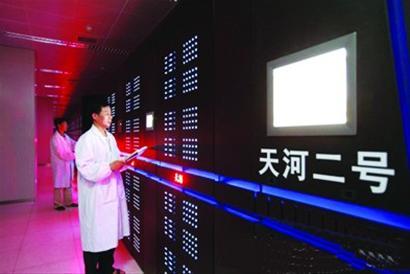ChineseTiger1986
ELITE MEMBER

- Joined
- Jan 27, 2010
- Messages
- 23,530
- Reaction score
- 12
- Country
- Location
Chinese cyber defenders against hackers' invasion.
These are China's white hackers or maybe red hackers.
Follow along with the video below to see how to install our site as a web app on your home screen.
Note: This feature may not be available in some browsers.

Chinese cyber defenders against hackers' invasion.




China is working on not one but three exascale computer prototypes, plus applications that will take full advantage of such powerful systems.
@Bussard Ramjet Time to get a move on buddy!
1016年10月10日在天津滨海新区,国防科技大学与国家超级计算天津中心举行 国家重点专项“高性能计算”项目 “E级计算机关键技术验证系统”、“面向E级高性能计算机的新型高性能互连网络技术研究”、“基于自主创新的石油地震勘探行业应用平台”联合启动会。来自科技部高技术中心、天津市科委、滨海新区科委、国防科大有关领导和“高性能计算”专项总体组专家、项目咨询专家、项目负责人、各课题负责人、参加单位代表近80人出席启动会。
此次启动项目涉及了E级超级计算机网络互联关键技术研发、E级超级计算基础芯片和系统设计,以及大规模高性能计算典型行业应用平台构建,代表了我国高性能计算生态系统中关键技术研发、系统研制和产业化应用创新的最前沿,也代表了我国未来高性能计算领域技术创新与应用转化并重的发展思路。
当前,超级计算创新研发已经成为一个国家电子信息技术发展的核心动力,而超级计算能力应用也同时成为国家科技创新和产业发展的强大支撑。结合国家创新驱动发展战略和“十三五”规划,2016年国家重点研发计划“高性能计算”专项重点面向E级超级计算机关键技术突破和系统研制、行业能力型重大应用软件系统的研发和构建能力型行业重大应用数值模拟软件平台、建立具有世界一流资源能力和服务水平的国家高性能计算环境三个层面展开。“高性能计算”重点专项首批支持的19个项目顺利完成立立项,本次首先启动三个项目。其中“E级计算机关键技术验证系统”、“基于自主创新的石油地震勘探行业应用平台”均由天津市推荐申报,落地滨海新区。
天津市、滨海新区已将推动百亿亿次超级计算机研制和落地列入区域创新驱动发展规划,并为E级计算机关键技术验证系统项目提供专项配套资金;下一步天津和滨海新区将继续加强与国防科大合作,推动E级超级计算机研制工作落地天津,深入服务国家创新驱动发展、京津冀协同发展和一带一路等战略实施。
相关启动项目情况介绍
“E级计算机关键技术验证系统”项目,下设5个课题,分别由国防科学技术大学、国家超级计算天津中心、浪潮公司、中山大学和湖南大学负责,项目执行周期三年。项目将针对E级系统构建所面临的功耗、可扩展性、可靠性及可编程性等挑战,探索可行的技术路线,突破体系结构、微处理器、互连、大规模并行软件环境等关键技术,并构建E级验证系统,验证未来E级系统的构建技术。
“面向E级高性能计算机的新型高性能互连网络技术研究”项目,下设5个课题,分别由国防科学技术大学计算机学院、中国科学院计算技术研究所、上海交通大学、西安交通大学和湖南大学负责,项目执行周期三年。项目主要是探索适应E级计算机要求的高性能互联技术,在速度、功耗、可扩展性等方面满足E级系统互连的要求,实现高性能网络与国产处理器的深度融合,支持构建系统弹性可扩展、与应用特征相匹配的融合多协议高性能高密度新型互连网络。
“基于自主创新的石油地震勘探行业应用平台”项目,下设4个课题,分别由国家超级计算天津中心、中石油东方地球物理勘探有限公司、吉林大学和中国工程物理研究院计算机应用研究所负责,项目研制周期四年半。项目将针对石油地震勘探行业的应用问题,建立行业应用平台,实现地震数据处理与解释一体化、生产业务与技术研发一体化、高性能计算与海量数据存储管理一体化,并依托平台开发和应用推广,探索基于超级计算系统的行业集成业务平台的市场化可持续发展模式。
10月20日,由中科曙光牵头的"E级高性能计算机原型系统研制"项目启动会在京召开,标志着在国家"十三五"高性能计算专项课题中,唯一一项由企业牵头的E级高性能计算机项目正式进入系统研制阶段,我国高性能计算系统的整体研制能力即将踏上新的征程。
E级高性能计算机是指每秒可进行百亿亿次计算的超级计算机,被全世界公认为"超级计算机界的下一顶皇冠",是各国竞相角逐的战略"制高点"。目前,美国、欧洲、日本等国家和地区都提出了自己的E级超算研发计划。在我国"十三五"高性能计算专项课题中,中科曙光、国防科技大学以及江南计算技术研究所同时获批牵头E级高性能计算的原型系统研制项目,形成了中国E级高性能计算"三头并进"的局面。
十多年来,曙光一直专注并致力于高性能计算产业,让世界见证了"中国速度"。曙光公司和中科院计算所先后研制完成了从曙光1号到曙光6000共7代高性能计算机,掌握了高性能计算机HPP体系结构、高效能刀片服务器、3D-Torus网络、高性能网络交换机、大规模并行存储等一系列核心技术并逐步实现了高性能计算系统产业化,具有强大的研发实力,为中国高端计算机依靠进口的局面画上了休止符,让中国跃入高性能计算机世界强国之列。
据中科曙光公司总裁历军介绍,E级高性能计算机原型系统研制项目将紧密围绕"高性能计算"重点专项的总体目标,面向国家战略、经济与社会重大挑战性的应用需求,将E级高性能计算技术产业化,深入支撑深度学习、大数据、云计算等领域的发展应用。
科技部高技术中心高级项目主管谈儒云认为,此次项目启动将涉及计算系统、网络架构、存储架构、系统软件、冷却系统、应用支撑等多方面研究方案,不仅要在能效等关键技术上取得突破,更要面临生态环境、可靠性、应用编程、存储、多领域应用的融合等多方面挑战。E级高性能计算机的建设,代表着我国高性能计算系统整体设计质的突破和性能的综合提升。
中国电力科学研究院周孝信院士表示,E级高性能计算机的研制,有望进一步提高研究人员、工程师、科学家建模与仿真等研究的水平,有助于解决电力行业的挑战性问题。
"包括E级高性能计算技术在内,所有的技术都应该为应用服务。"历军表示,如果高性能计算机只应用于传统科研领域,无法进入大众市场,将难以推动我国其他行业快速发展。以工业标准技术为基础的曙光E级高性能计算系统,将为国家科技创新和产业转型升级提供基础设施保障,推动我国基础科学研究、工业转型升级、信息化行业发展等
E级超算:“下一顶皇冠”
E级高性能计算机(简称“E级超算”)是指每秒可进行百亿亿次数学运算的超级计算机,被全世界公认为“超级计算机界的下一顶皇冠”。
E级超算将在解决人类共同面临的能源危机、污染和气候变化等重大问题上将发挥巨大作用。中国计算机学会高性能计算专委会秘书长、中科院计算所研究员张云泉指出,E级超算可以应对一些具有重大计算的需求,如全球气候变化模拟、天体物理大数据的处理(如SKA项目)、模拟宇宙的演化、模拟新型材料及核武器等。同时,除了科学计算,它也将在深度学习、大数据、云计算等领域发挥重大价值,帮助提高人们对各领域日益剧增的海量数据处理利用的能力,并从中发现新事物、新规律和新机会。另外,通过研制E级超算,还可以对上下游的核心技术和关键部件的研发、应用环境和软件的孵化产生积极的促进作用。因此,E级超算具有极高的科学、社会、经济和产业生态价值。
作为大国综合实力的象征,尤其是衡量一国科技创新实力的标志,E级超算已成为当前各国竞相角逐的战略制高点。美国、欧洲、日本等国都提出了自己的E级超算研发计划,中国也将百亿亿次超级计算机的研究写入了国家“十三五”规划中,并计划于2020年对外发布。
http://server.zdnet.com.cn/server/2016/0629/3079851.shtml





https://defence.pk/threads/india-be...for-space-meteorological-applications.343923/Billion billion calculations per second: where no computer has gone before
China joins the race to build the first exascale computer by 2020, or before
PUBLISHED : Saturday, 29 October, 2016, 8:00am
UPDATED : Saturday, 29 October, 2016, 8:00am
Viola Zhou
China has started to develop its first exascale computer capable of performing a billion billion calculations per second, as the country steps up efforts to stay in the lead of the global supercomputer race.
The high-performance computer, if it can be built by 2020, will boost the country’s scientific capability and possibly maintain its prestige of housing the world’s fastest calculating system.
The exascale supercomputer will operate at 1,000 petaflops, or quadrillion calculations per second, 10 times the speed of China’s TaihuLight, which topped a 2016 global supercomputer speed list.
With an official goal to put an exascale computer into service in five years, the Ministry of Science and Technology recently funded three research institutions to develop prototypes, Xinhua said.
When these are completed, the ministry will pick two teams with the best designs to build the fully-functioning exascale supercomputer, said An Hong, a computer scientist at the University of Science and Technology of China.
An, who has been training Chinese researchers to use supercomputers, said existing machines still failed to provide the speeds required to study new materials, develop drugs and design nuclear power plants.
“The demand in computing speed has no limits,” An said. “Now we have the money and technology, we can build better computers for scientists to use.”
The top tech enterprise Sugon, which built the Dawning supercomputers, was the first to kick off the exascale computer project, Xinhua reported.
The National University of Defence Technology, which is under the direct leadership of the Central Military Commission, joined the competition in October, aiming to finish the prototype by early 2018. The military academy developed the former world champion Tianhe-2 supercomputer.
This week, the National Research Centre of Parallel Computer Engineering and Technology, which developed TaihuLight, started work on its new machine.
This year, China displaced the US for the first time as the country with the most supercomputers in TOP500. China had 167 systems to the Americans’ 165.
Japan and France are also aiming to develop exascale systems by 2020, while the US will have its own by 2023.
http://www.scmp.com/news/china/econ...alculations-second-where-no-computer-has-gone




nothing special. india will release 132.8 exaflops cowputer next year.
it's no humor. this is serious sh1t man. i might have to eat me own poop on youtube as promisedI love your humor!



